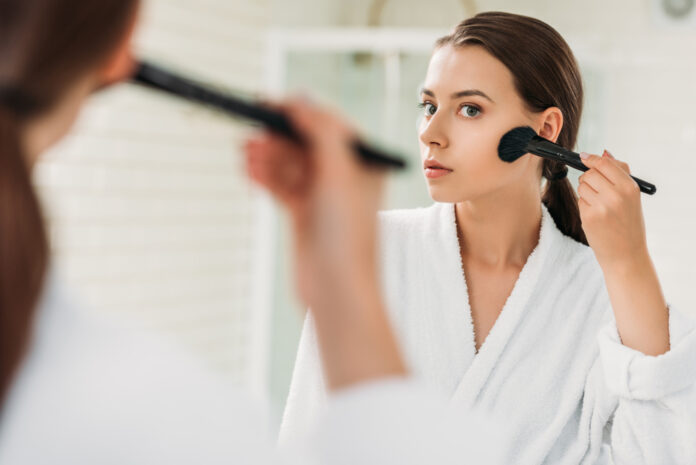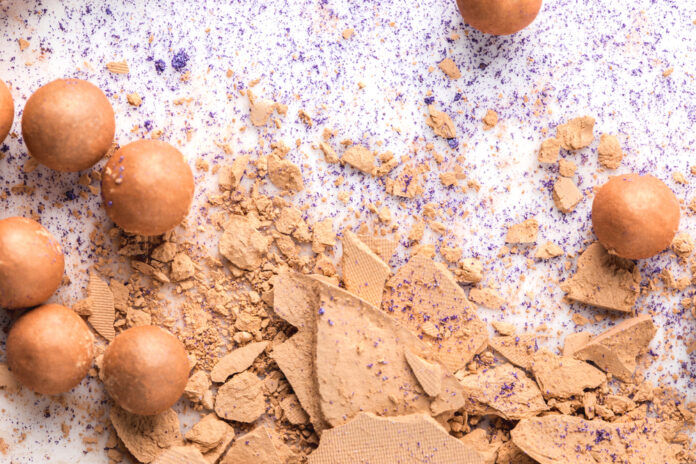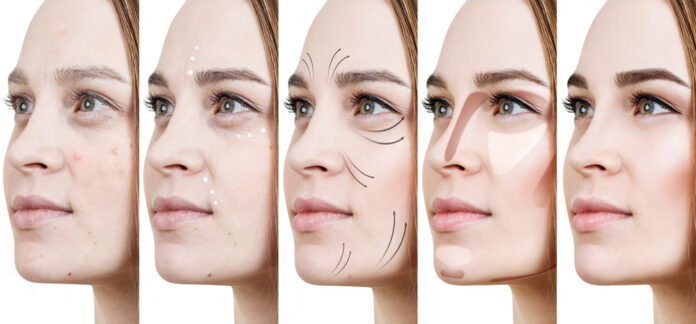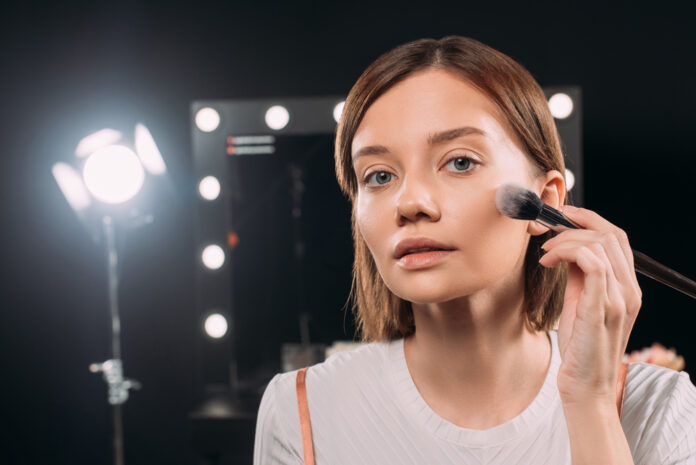A glowing, sun-kissed look is a hit year-round. Even when you cannot get a natural tan, whether it be because of the weather or because your busy schedule keeps you chained to the office, you can replicate the look using bronzer and contour.
Both bronzer and contour are staples of every makeup artist’s (and amateur fashionista’s) makeup bag. They both create depth on the face and replicate the sun’s glow. However, they are not interchangeable.
Here is your guide to the differences between bronzer and contour, as well as the best ways to use each so you look like a sun-lit goddess.
What Is Bronzer?
Bronzer is a powder that adds warmth to your face by mimicking a sunny glow. Even a few years ago, bronzer tended to make its users look unfortunately orange. Luckily, cosmetic formulas have improved since then and bronzers come in a variety of tones that can look natural on all skin types. Just be sure to choose a shade that is only a few shades darker than your skin to avoid looking orange.
Most bronzers come in powder form, so you need a makeup brush to apply them. It can also come in cream or liquid form, in which case you would use a makeup sponge. Whichever method of application you choose, touch bronzer along the high points of your face: your cheekbones, hairline, and the tip of your nose. Some makeup artists like to draw a 3 shape with bronzer.
When it comes to bronzer, a natural look is best. Be sure not to apply too much bronzer and to apply it strategically only to the parts of your face that naturally reflect the most light from the sun. Then, blend the bronzer out thoroughly by drawing small circles, which will create a natural gradient with the rest of your skin.
What Is Contour?
While bronzer is a method of highlighting your face, contour lives in the shadows. Contouring is a makeup technique that enhances the natural shadows of the face for a more angular, chiseled look. To achieve this look, you need to use highlighter and contour powder in tandem. Contour powder is usually a darker, matte powder, compared to bronzer, which is shiny.
To choose the best contour shade, most makeup artists recommend going two or three shades darker than your normal shade and paying attention to whether your skin has cool, neutral, or warm undertones. The few shades difference will be enough to create emphasis, but if you go too dark you are in danger of looking skeletal.
Contour comes in a cream or powder formula. You can use a makeup sponge or brush to apply it. How you apply contour depends on your face shape and the look you are going for. Most people choose to apply contour underneath the cheekbones, along the jawline, and on the sides of the nose. This creates shadows in those areas, which creates a more angular look overall. Some makeup artists swear by the “3” method for applying contour—sweep contour along your face while drawing the number 3, so you hit the forehead, cheekbones, and jaw.
Once you contour, blend it into the rest of your skin just like bronzer. You don’t want any obvious contour lines because that will make your whole face look unnatural.
Benefits of Bronzer
Bronzer adds a shiny tone to your skin and is the closest you can get to mimicking a sun-kissed look without tanning. It also adds warmth to the face, which can liven up your skin after a cold winter.
However, bronzer cannot alter your face shape as contour does. You also need to be sparing with the application—even the most advanced bronzer formula can make you turn an unfortunate shade of orange if you apply too much.
Benefits of Contour
If you are insecure about a weak chin or undefined cheekbones, contour is your friend. With contour, you can mimic a different face structure or enhance the features that you are proudest of.
However, you cannot get a sun-kissed glow from contour alone because it can only create shadows. Contour also needs to be applied more strategically than bronzer because applying too much can make you look clownish.
How to Use Bronzer and Contour in Tandem
Ultimately, bronzer and contour serve different purposes. They go on different portions of your face—apply bronzer to areas of the face that naturally tan, while contour goes in the shadows. They have different textures—bronzer is shiny while contour powder needs to be matte. They can even be different shades.
You can apply bronzer and contour in tandem to create the ultimate sun-kissed look. First, apply bronzer to the natural high points of your face, such as your forehead, cheekbones, and nose. Then, apply contour underneath those points, just as you would apply it if you were using it with highlighter. As always, remember to blend for a natural look.
However, you should never attempt to use bronzer instead of contour powder, or vice versa. Bronzer is not defined enough to create the shadows that you want when you contour. Contour powder tends to be cooler tones, so using it as a bronzer will make your face look washed out instead of warm.
Tips for the Sun-Kissed Look
Whether you are using bronzer, contour, or both, here are a few tips for ensuring that your sun-kissed look is a success.
When applying both products, use them as sparingly as possible. Too much of either bronzer or contour can make your face look artificial or even clownish. You can always add more if you think that it is not executing the effect properly.
Blend until you think you’ve blended enough, then blend some more. This is key to achieving a natural look. Don’t forget to blend makeup into your neck or apply some below your jawline, otherwise, the transition will look too unnatural.
Finally, experiment a bit until you find the products and techniques that work best for you! You deserve to have that sun-kissed glow whether you have time to tan or not.
Can You Use a Bronzer to Contour?
Most of the time, you cannot replace contour powder with a bronzer. Bronzer is too shiny and warm to create the cool, defined shadows you hope to achieve when you contour.
However, if you have no contour at home, you can try achieving minimal definition by brushing bronzer below your cheekbones. This works best if you have a cooler undertone on your skin because a glowing bronzer will make warm skin tones exaggerated. Be sure to blend thoroughly and apply as little bronzer as possible.
Although it is possible to contour with bronzer, the results are not guaranteed and it is best to turn to contour powder.
Is Bronzer the Same as Contour?
No, bronzer is not the same as contour. They share some similarities. Both are makeup products used to add definition to the face. Both come in liquid, powder, or cream forms, and can be applied using a brush or makeup sponge.
However, bronzer has warm tones and a shiny finish. It is used to add a sun-kissed glow to skin. By contrast, contour tends to come in cooler tones and has a matte finish. It is used to create shadows on the face that create a more angular look. They are also applied to different areas of the face.
What Is the Point of Bronzer?
If you don’t have time to lay on the beach or just want to enhance your natural tan, then bronzer is one of your best friends. Bronzer creates depth and definition on the skin by adding a warm glow to the high points of the skin.
When used properly, bronzer has a more subtle effect than contour. It just adds a little sheen and glow to the face. It can also lift shallow skin tones by adding warmth to cooler faces. It should create a natural, healthy look. The point of bronzer isn’t in the details of its application but the overall effect.
Where Do You Apply Contour and Bronzer?
You should apply bronzer to the high points of your face. Think about the effect when you tan. Where on your face do you tend to pick up the most glow? When you apply bronzer, pay attention to those areas.
If it’s been so long since you tanned that you can’t remember, a good rule of thumb is to apply bronzer on the apples of your cheeks, along the hairline, and on the tip of your nose.
Contour’s purpose is to create shadow, so it should go under bronzer. Apply it under the cheekbones, along your jawline, and on the side of your nose.
What Comes First, Bronzer or Contour?
There are a few different techniques for applying bronzer and contour. Some people suggest applying bronzer first, similarly to a highlighter. This allows you to blend the bronzer into your skin, creating a natural glow. Then, you apply contour, using the bronzer as a guide for areas that need some more shadow.
According to another method, you should apply contour first. Then, you can strategically apply bronzer on top to highlight areas of the face that you like and create the overall effect of a natural glow.
Most people apply bronzer first, but you can experiment a little to figure out what works best for you.
Should I Use Blush or Bronzer?
Blush and bronzer have similar purposes. They both add warmth and depth to the face by highlighting a few strategic areas. The biggest difference is in their hues—while bronzer creates a golden, sun-kissed look, blush creates a rosier appearance.
The season can affect your choice. Bronzer looks more natural in the summer, while in the winter everyone can tell that your glow is artificial. Blush is a great choice for the winter as it livens up dull, pale skin. Blush is also more subtle as it targets only the cheeks, as opposed to bronzer, which goes on several different areas of the face.






